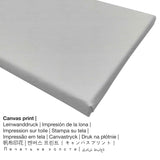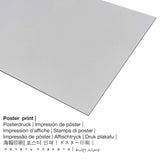Winslow Homer, 1903 - Early Morning After a Storm at Sea - fine art print
Tax included. Shipping calculated at checkout.
In 1903 the painter Winslow Homer made this work of art. The more than 110 years old original version measures the size: Framed: 111 x 160 x 12 cm (43 11/16 x 63 x 4 3/4 in); Unframed: 76,8 x 127 cm (30 1/4 x 50 in). Oil on canvas was applied by the American artist as the technique for the painting. The artwork's inscription is: "signed lower left: "HOMER / 1902"". Furthermore, the piece of art is included in the digital collection of The Cleveland Museum of Art in Cleveland, Ohio, United States of America. This modern art artwork, which is part of the public domain is supplied with courtesy of The Cleveland Museum of Art. Besides, the work of art has the following creditline: Gift of J. H. Wade. On top of that, alignment of the digital reproduction is landscape with a side ratio of 16 : 9, which means that the length is 78% longer than the width. The painter Winslow Homer was an artist, whose artistic style was primarily Realism. The artist lived for 74 years and was born in the year 1836 in Boston, Suffolk county, Massachusetts, United States and died in 1910.
Which item material do you like most?
In the dropdown selection right next to the product offering you can pick the material and sizeaccording to your individual preferences. We allow yout to choose among the following variants:
- The poster print (canvas material): The poster print is a printed sheet of flat canvas paper with a fine surface structure. A printed poster is suited for framing the art print with a personal frame. Please bear in mind, that depending on the size of the canvas poster print we add a white margin 2-6cm around the work of art, which facilitates the framing.
- Aluminium dibond print (metal): Aluminium Dibond prints are metal prints with a true effect of depth. Its non-reflective surface structure make a modern look. A direct Direct Print on Aluminum Dibond is your ideal start to fine replicas on aluminum. For your Print On Aluminum Dibond, we print your chosen artwork on the surface of the aluminum material. The white & bright components of the artpiece shimmer with a silky gloss, however without any glow.
- Canvas print: A canvas print is a printed cotton canvas stretched on a wood frame. Canvas prints are relatively low in weight, which means that it is easy to hang up the Canvas print without the use of extra wall-mounts. Because of thatcanvas prints are suited for all types of walls.
- Print on glossy acrylic glass (with real glass coating): A glossy acrylic glass print, often described as a UV print on plexiglass, will change your favorite artwork into great wall decoration. The great upside of a plexiglass fine art print is that sharp contrasts plus small color details will be more visible with the help of the subtle gradation of the picture. The acrylic glass protects your selected fine art print against light and external influences for many decades.
Important note: We try all that we can to describe the products in as much detail as possible and to exhibit them visually in our shop. However, the colors of the printing material, as well as the printing can differ marginally from the representation on the screen. Depending on the screen settings and the condition of the surface, not all color pigments are printed as realistically as the digital version shown here. Since all our are printed and processed by hand, there may as well be minor differences in the motif's size and exact position.
Structured item details
| Article classification: | wall art |
| Method of reproduction: | digital reproduction |
| Manufaturing technique: | digital printing |
| Provenance: | made in Germany |
| Type of stock: | production on demand |
| Intended usage: | art print gallery, home décor |
| Alignment: | landscape alignment |
| Image aspect ratio: | length to width 16 : 9 |
| Image aspect ratio interpretation: | the length is 78% longer than the width |
| Available product fabrics: | acrylic glass print (with real glass coating), poster print (canvas paper), canvas print, metal print (aluminium dibond) |
| Canvas on stretcher frame (canvas print) size variants: | 90x50cm - 35x20", 180x100cm - 71x39" |
| Acrylic glass print (with real glass coating): | 90x50cm - 35x20" |
| Poster print (canvas paper): | 90x50cm - 35x20" |
| Dibond print (alumnium material) variants: | 90x50cm - 35x20" |
| Framing of the art reproduction: | without frame |
Structured table of the artwork
| Name of the artwork: | "Early Morning After a Storm at Sea" |
| Artwork classification: | painting |
| General term: | modern art |
| Time: | 20th century |
| Created in: | 1903 |
| Approximate age of artwork: | 110 years |
| Medium of original artwork: | oil on canvas |
| Size of the original artpiece: | Framed: 111 x 160 x 12 cm (43 11/16 x 63 x 4 3/4 in); Unframed: 76,8 x 127 cm (30 1/4 x 50 in) |
| Signature: | signed lower left: "HOMER / 1902" |
| Museum: | The Cleveland Museum of Art |
| Museum location: | Cleveland, Ohio, United States of America |
| Website of Museum: | The Cleveland Museum of Art |
| License: | public domain |
| Courtesy of: | The Cleveland Museum of Art |
| Artwork creditline: | Gift of J. H. Wade |
Artist overview table
| Name: | Winslow Homer |
| Aliases: | homer w., Homer, Homer Winslow, Winslow Homer, w. homer, הומר וינסלאו |
| Gender of the artist: | male |
| Nationality of artist: | American |
| Professions: | painter |
| Country: | United States |
| Classification of the artist: | modern artist |
| Styles of the artist: | Realism |
| Died at the age of: | 74 years |
| Year of birth: | 1836 |
| Place of birth: | Boston, Suffolk county, Massachusetts, United States |
| Year of death: | 1910 |
| City of death: | Prouts Neck, Cumberland county, Maine, United States |
Copyright ©, Artprinta.com (Artprinta)
Artwork information by The Cleveland Museum of Art (© Copyright - by The Cleveland Museum of Art - The Cleveland Museum of Art)
The powerful Atlantic surf pounding against the desolate coast of Prouts Neck, Maine, provided primary subject matter for the dramatic paintings that Homer created during his final decades. This example, which the artist proclaimed as "the best picture of the sea that I have painted," was initially conceived as a watercolor. Undertaking the composition in oil after a lapse of nearly two decades, Homer patiently waited for the appropriate atmospheric conditions, executing the work in four different sessions spread over two years.














